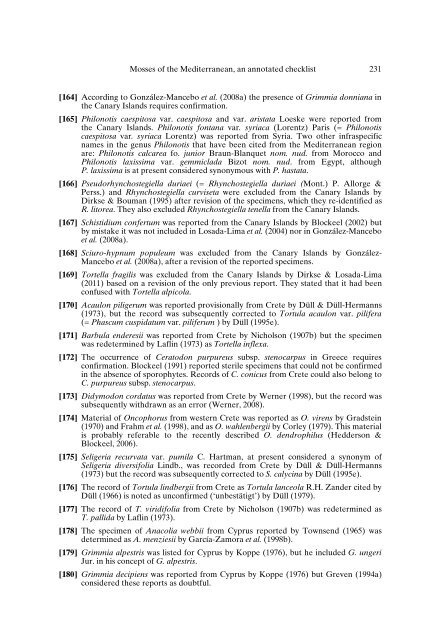Mosses of the Mediterranean, an annotated checklist - Optima-bot.org
Mosses of the Mediterranean, an annotated checklist - Optima-bot.org
Mosses of the Mediterranean, an annotated checklist - Optima-bot.org
Create successful ePaper yourself
Turn your PDF publications into a flip-book with our unique Google optimized e-Paper software.
<strong>Mosses</strong> <strong>of</strong> <strong>the</strong> <strong>Mediterr<strong>an</strong>e<strong>an</strong></strong>, <strong>an</strong> <strong>an</strong>notated <strong>checklist</strong> 231[164] According to González-M<strong>an</strong>cebo et al. (2008a) <strong>the</strong> presence <strong>of</strong> Grimmia donni<strong>an</strong>a in<strong>the</strong> C<strong>an</strong>ary Isl<strong>an</strong>ds requires confirmation.[165] Philonotis caespitosa var. caespitosa <strong>an</strong>d var. aristata Loeske were reported from<strong>the</strong> C<strong>an</strong>ary Isl<strong>an</strong>ds. Philonotis font<strong>an</strong>a var. syriaca (Lorentz) Paris (= Philonotiscaespitosa var. syriaca Lorentz) was reported from Syria. Two o<strong>the</strong>r infraspecificnames in <strong>the</strong> genus Philonotis that have been cited from <strong>the</strong> <strong>Mediterr<strong>an</strong>e<strong>an</strong></strong> regionare: Philonotis calcarea fo. junior Braun-Bl<strong>an</strong>quet nom. nud. from Morocco <strong>an</strong>dPhilonotis laxissima var. gemmiclada Bizot nom. nud. from Egypt, althoughP. laxissima is at present considered synonymous with P. hastata.[166] Pseudorhynchostegiella duriaei (= Rhynchostegiella duriaei (Mont.) P. All<strong>org</strong>e &Perss.) <strong>an</strong>d Rhynchostegiella curviseta were excluded from <strong>the</strong> C<strong>an</strong>ary Isl<strong>an</strong>ds byDirkse & Boum<strong>an</strong> (1995) after revision <strong>of</strong> <strong>the</strong> specimens, which <strong>the</strong>y re-identified asR. litorea. They also excluded Rhynchostegiella tenella from <strong>the</strong> C<strong>an</strong>ary Isl<strong>an</strong>ds.[167] Schistidium confertum was reported from <strong>the</strong> C<strong>an</strong>ary Isl<strong>an</strong>ds by Blockeel (2002) butby mistake it was not included in Losada-Lima et al. (2004) nor in González-M<strong>an</strong>ceboet al. (2008a).[168] Sciuro-hypnum populeum was excluded from <strong>the</strong> C<strong>an</strong>ary Isl<strong>an</strong>ds by González-M<strong>an</strong>cebo et al. (2008a), after a revision <strong>of</strong> <strong>the</strong> reported specimens.[169] Tortella fragilis was excluded from <strong>the</strong> C<strong>an</strong>ary Isl<strong>an</strong>ds by Dirkse & Losada-Lima(2011) based on a revision <strong>of</strong> <strong>the</strong> only previous report. They stated that it had beenconfused with Tortella alpicola.[170] Acaulon piligerum was reported provisionally from Crete by Düll & Düll-Herm<strong>an</strong>ns(1973), but <strong>the</strong> record was subsequently corrected to Tortula acaulon var. pilifera(= Phascum cuspidatum var. piliferum ) by Düll (1995e).[171] Barbula enderesii was reported from Crete by Nicholson (1907b) but <strong>the</strong> specimenwas redetermined by Laflin (1973) as Tortella inflexa.[172] The occurrence <strong>of</strong> Ceratodon purpureus subsp. stenocarpus in Greece requiresconfirmation. Blockeel (1991) reported sterile specimens that could not be confirmedin <strong>the</strong> absence <strong>of</strong> sporophytes. Records <strong>of</strong> C. conicus from Crete could also belong toC. purpureus subsp. stenocarpus.[173] Didymodon cordatus was reported from Crete by Werner (1998), but <strong>the</strong> record wassubsequently withdrawn as <strong>an</strong> error (Werner, 2008).[174] Material <strong>of</strong> Oncophorus from western Crete was reported as O. virens by Gradstein(1970) <strong>an</strong>d Frahm et al. (1998), <strong>an</strong>d as O. wahlenbergii by Corley (1979). This materialis probably referable to <strong>the</strong> recently described O. dendrophilus (Hedderson &Blockeel, 2006).[175] Seligeria recurvata var. pumila C. Hartm<strong>an</strong>, at present considered a synonym <strong>of</strong>Seligeria diversifolia Lindb., was recorded from Crete by Düll & Düll-Herm<strong>an</strong>ns(1973) but <strong>the</strong> record was subsequently corrected to S. calycina by Düll (1995e).[176] The record <strong>of</strong> Tortula lindbergii from Crete as Tortula l<strong>an</strong>ceola R.H. Z<strong>an</strong>der cited byDüll (1966) is noted as unconfirmed (‘unbestätigt’) by Düll (1979).[177] The record <strong>of</strong> T. viridifolia from Crete by Nicholson (1907b) was redetermined asT. pallida by Laflin (1973).[178] The specimen <strong>of</strong> Anacolia webbii from Cyprus reported by Townsend (1965) wasdetermined as A. menziesii by García-Zamora et al. (1998b).[179] Grimmia alpestris was listed for Cyprus by Koppe (1976), but he included G. ungeriJur. in his concept <strong>of</strong> G. alpestris.[180] Grimmia decipiens was reported from Cyprus by Koppe (1976) but Greven (1994a)considered <strong>the</strong>se reports as doubtful.






